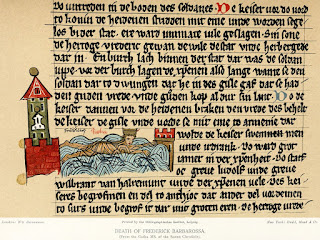The other designation was High King of Ireland, or King of All Ireland. This designation was not rooted in Irish mythology: it denoted someone powerful enough that other kingdoms recognized his political and military superiority. There was no spiritual or religious aspect to this title.
Diarmait Mac Cerbaill was the last known king in Ireland to go through the pagan ritual of marriage to the goddess of the land, and so was King of Tara. Annals declare him a great-grandson of the semi-historical Niall of the Nine Hostages. His father's name was Fergus, but rather than be named "Ferguson," his surname is given as Cerbaill from his father's nickname Cerrbél, "crooked mouth."
During his lifetime, he was also declared High King of Ireland, from 544 to 565. His reign was not stellar. In a dispute between St. Columba and Finnian of Movilla, he took the wrong side and was defeated at the Battle of Cúl Dreimhne, the famous "Battle of the Books" over the copyright of the Cathach. It was not the only battle he lost.
Despite his initiation as King of Tara, and references to "druid fences" being used during the Battle of Cúl Dreimhne, he was the first High King in Ireland to embrace (or at least dabble in) Christianity. Adomnán of Iona wrote that Diarmait was "ordained by God's will as king of all Ireland." Adomnán was writing 150 years later, but it is not the only evidence that Diarmait might have begun forging a healthy relationship with Christianity. He supported St. Finnian of Movilla. The stone pictured above is believed to be Diarmait and St. Ciaran, carved into the Cross of the Scriptures at Clonmacnoise, planting a stake together. There is a quotation attributed to him that suggests respect for the power of Christianity: "Woe to him that contends with the clergy of the churches." Also, curiously, two of his sons are called Colmán, a specifically Christian name based on the 6th century Irish missionary, St. Columbanus. (Irish royals were known to give the same name to more than one son—relying on nicknames later to distinguish them?—until the 16th century.)
The end of his life, however, was decidedly non-Christian; rather, it involves a mythical "threefold death" based in prophecy that seems impossible at first but comes true in a logical manner. It's complicated enough that I think I'll save it until tomorrow. See you then.














